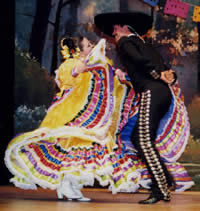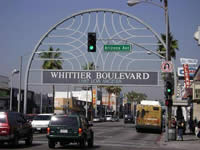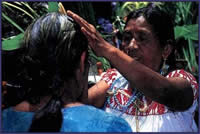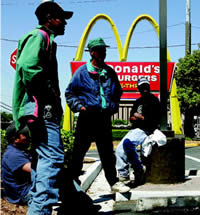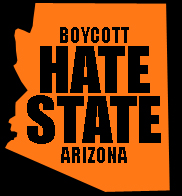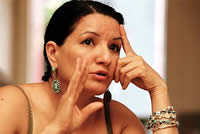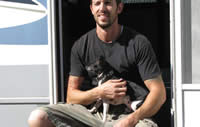Course Information Overview
- CH S 508 Research Seminar: Transdisciplinary Methodologies and Qualitative Investigative Approaches
- Class Time and Day(s)
- Classroom Building and Room Number
- Additional facilities (if applicable…labs, practice rooms, studios)




Course Description
This graduate seminar introduces students to transdisciplinary approaches, critical theory, field work principles, and ethnographic methods intended for qualitative research applications involving various types of Chicana/o and/or Latina/o studies and investigations. Students conduct actual field, archival, literary and transdisciplinary research within various Chicana/o and/or Latina/o communities and present their data and project updates in class throughout the term. Students begin to develop long term investigative projects involving field research, archival investigations, literary and media studies, critical race, ethnicity, class, gender, and sexuality and identify funding sources intended for future dissertation projects. Seminar topics include: ethnographic method and critical theory, approaches to and problems of fieldwork; subject position and objectivity; cultural, geographic, and decolonial studies; Chicana and third world feminism; radical semiotics, pedagogy, and public policy; reflexivity and auto-ethnography; technology, media, and computer software; ethical issues and political activism; emic/native and etic/outsider perspectives; documentation, collection, and archiving; researcher’s affecting presence on a community and ongoing rapport with research associates (informants); interviewing techniques and rhetorical strategies; participant observation, listening, and questioning; discursive and intertextual analysis; cultural poetics; questionaires; literary, his(hers)torical, demographic (social geographic) and humanities approaches; and the current debates over postmodernism and postcolonialism within the ongoing experimental moment in social science.
Suffice it to say that due to the urgency of our times, auto-ethnography is an individual attempt at writing that responds to the epic global crisis that characterizes our uncertain and politially unstable era. According to critical theorist Mary Louise Pratt, I use the term [autoethnography and autoethnographic expression] to refer to instances in which colonized subjects undertake to represent themselves in ways which engage with the colonizer’s own terms. If ethnographic texts are a means in which Europeans represent themselves their (usually subjugated) others, autoethnographic texts are those the others construct in response to or in dialogue with those metropolitan representations (1992, 6-7 emphasis original).
Because cultures exist through human interaction; ethnography is an excellent way to investigate the nature of society, politics, ethnic endurance, social determination, and history. Among anthropologists, the move toward multisited ethnography gives rise to three sets of methodological anxieties. These are, according to George Marcus: “a concern about testing the limits of ethnography, a concern about attenuating the power of fieldwork, and a concern about the subaltern” (1995, 100). Marcus argues that “ethnography is predicated upon attention to the everyday, an intimate knowledge of face-to-face communities and groups. The idea that ethnography might expand from its committed localism to represent a system much better apprehended by abstract models and aggregate statistics seems antithetical to its very nature, and thus beyond its limits” (1995, 100). He explains, Although multi-sited ethnography is an exercise in mapping terrain, its goal is not holistic representation, an ethnographic portrayal of the world system as a totality. Rather, it claims that any ethnography of a cultural formation in the world system is also an ethnography of the system, and therefore cannot be understood only in terms of the conventional single-site mise-en-scene of ethnographic research, assuming indeed it is the cultural formation, produced in several different locales, rather than the conditions of a particular set of subjects that is the object of study. (1995, 99)
A seminar is a contract between people to be prepared—every day—to explore the boundaries of knowledge. A dynamic seminar is one in which the members work together to help each other understand the readings and conversations. There is likely to be nothing more exhilarating in your graduate years at college than the experience of a really good seminar. The most important part of a seminar is keeping up with, or exceeding, the reading. If you do the reading, come to class, and familiarize yourself with the following seminar skills and approaches, you are almost certain to have vibrant, dynamic, and lively seminars. Remember that you are important—vital—to the seminar and you are also the teacher and are responsible for what you believe the group needs to learn. Please read Appendix 7B: Introduction to Seminaring in the Hutchins School of Liberal Studies (pp. 442-444) in Latina/o Thought: Culture, Politics, and Society edited by Francisco H. Vasquez and Rudolfo Torres for appropriate skills and approaches vital to the success of CHS508 Research Seminar: Transdisciplinary Methods and Qualitative Investigative Applications
Grading
Additional Readings As Required: Student interests help shape the exact journal articles or book excerpts we may choose to include. Feel free to recommend readings throughout the term that may be useful or interesting.
3 Class Presentations/Précis and Discussion Questions
(7 points)…………… 20 points
1 Oral Roundtable Presentation ………… 10 points
2 Final Project Updates (5 points)
and Write Up (10 points)……….…………..30 points
Written Assignments/Field Work/Grant Applications……………..…………….40 points
100 points
Student Learning Outcomes
This Graduate seminar is transdisciplinary in design and combines several pedagogical goals including introducing students to the rich history and diversity of human knowledge, discourse and achievements of their own Chicana/o and other Latina/o cultures as expressed in the arts, literatures, religions and philosophy. At the same time students will understand the complexities of social relations and human experiences and the ways in which they have changed over time, as well as the nature, scope, and the systematic study of human behaviors and societies. Students will understand the diversity and multiplicity of cultural forces that shape the world through the study of cultures, gender, sexuality, class, race, religion, ethnicities and languages with special focus on the contributions, differences, and global perspectives of diverse cultures and societies.
Students will:
- Explain and reflect critically upon the human search for meaning, values, discourse and expression in one or more eras/stylistic periods or cultures;
- Analyze, interpret, and reflect critically upon ideas of value, meaning, discourse and expression from a variety of perspectives from the arts, literature, and/or humanities;
- Explain how social scientists conduct the systematic study of social relations, human experiences and patterns of change over time;
- Analyze and explain the multiple perspectives found in the social sciences that underlie debates on important historical and contemporary issues;
- Apply appropriate social scientific methods to collect, data, analyze, evaluate, explain, and/or solve problems in social relations and human behavior;
- Demonstrate an understanding of how social problems impact individuals, communities, and societies;
- Explain how Chicana/o culture contributes to the development of our multicultural world;
- Describe how critical race, ethnicity, class, gender, religion, sexuality and other markers of social identity impact life experiences and social relations;
- Analyze and explain the deleterious impact and the privileges sustained by racism, sexism, ethnocentrism, classism, homophobia, religious and linguistic intolerance, anti-immigrant discrimination, and stereotyping on all sectors of society.
Course Schedule
Schedule of Topics and Detailed Course Calendar
Week 1: Introductions and Concepts √ Chicana/o Cultural Studies “On the Border” and Contentious Dialogues and Alternative Legacies
Read: “El Plan de Santa Barbara” in Chicano Coordinating Council on Higher Education, Santa Barbara: La Causa Publications (1970: 191-203);
(Vásquez and Torres) “General Introduction” pp. 1-9; “Introduction for Students: Power/Knowledge, Language, and Everyday Life” pp. 10- 22 in Latina/o Thought: Culture, Politics, and Society
Chabram-Dernersesian “Introduction to Part One” in The Chicana/o Cultural Studies Reader
Methodology: Chapter 1: “Defining Community” in Researching Chicano Communities: Social-Historical, Physical, Psychological, and Spiritual Space.
(Aldama, Arturo and Naomi H. Quiñonez) “¡Peligro! Subversive Subjects: Chicana and Chicano Cultural Studies in the 21st Century” in Decolonial Studies: Chicana and Chicano Cultural Studies in the 21st Century @2002: 1-29.
Rosa Linda Fregoso and Angie Chabram “Chicana/o Cultural Representations; Reframing Alternative Critical Discourses” Pp. 26-32 in The Chicana/o Cultural Studies Reader
Theory/Case Studies:
(Américo Paredes) “On Ethnographic Work among Minority Groups: A Folklorists’s Perspective” originally published in New Scholar 6: 1-32. 1979 (1993) in Folklore and Culture on the Texas-Mexican Border Austin: University of Texas at Austin Press. (Ignacio M. García) “Juncture in the Road: Chicano Studies since “El Plan de Santa Barbara” Pp. 181-203 in Chicanas/Chicanos at the Crossroads: Social, Economic, and Political Change edited by David R. Maciel and Isidro D. Ortiz Tucson: The University of Arizona Press @1996.
(Chabram-Dernersesian) “Introduction: Chicana/o Latina/o Cultural Studies: Transnational and Transdisciplinary Movements” in Cultural Studies 13(2) 1999, 173-194 or (Chabram-Dernersesian) “Chicana/o Cultural Studies Marking the Conjuncture within an Institutional Context” Pp. 39-46 in The Chicana/o Cultural Studies Reader.
Renato Rosaldo “Whose Cultural Studies” Pp. 33-38 in The Chicana/o Cultural Studies Reader
Notes and Garcia’s Questions: Provide an overview of Chicana/o Studies since El Plan de Santa Barbara. What kinds of investigations and approaches have emerged since el movimiento? Describe the Chicano critique of anthropology and how Ameríco Paredes mediated the charges? Define objectivity, cultural bias, and participant observation. How did previous Anglo anthropologists portray Mexican Americans in their ethnographic investigations? What does Paredes have to say about the importance of understanding language in its cultural context especially in folkloristic investigations? Describe the state of Chicano Studies today and the Transnational and Transdisciplinary directions in current research. What kind of investigations do you believe are most needed in Chicana/o communities and why is this research important? What value is ethnography to Chicanas/o Studies today? Discuss the methodological approach used in the video documentary “Mexican Americans” in relation to the social base. What political, social, and cultural issues are raised in the literature and the video.
Due: Brief biographical sketch describing your academic and personal background, research/teaching experience and personal interests, awards and academic/social honors, hobbies, sports, political causes, and activism. Explain why you chose Chicana/o Studies for a graduate program and what you are hoping to accomplish in graduate school (degrees, careers, research projects, personal growth). Explain how your degree will help you to realize your long-term plans and projects. What do you hope to learn this term and how may García assist you with your broader academic plans? (1 page single spaced) [2 pt.]; Resumé or Curriculum Vitae [3 pt.]
View: The Mexican Americans
Recommended Readings: (Vila) “Introduction: Border Ethnographies”, ix-xxxv in Ethnography at the Border edited by Pablo Vila, Minneapolis: University of Minnesota Press @2003
Week 2: Literature Search and Review/Defining the Social Base
Read: [Carved Out of Language: Literary and Historical Discourses] (“Corky” Gonzalez) “I am Joaquin (1967)” (pp. 75-88); (Hernández-Vásquez) “América’s Patriots Then and Now: Anticolonial Struggles and Latino/a Political Thought” (pp.88-100) in Latina/o Thought: Culture, Politics, and Society edited by Francisco H. Vasquez and Rudolfo Torres. Answer questions following each chapter.
Methodology: Blea Chapter 2: “Reviewing the Literature” in Researching Chicano Communities: Social-Historical, Physical, Psychological, and Spiritual Space.
(Sanchez) “Adopting Transnationalism Theory and Discourse: Making space for a transnational Chicana” in Discourse: Studies in the Cultural Politics of Education, Vol. 22, no. 3 @2001: 375-381.
(Chapin) Reflections from the Bridge”, 1-22 in Ethnography at the Border .
Theory/Case Studies:
(Wright) “the Politics of Relocation: Gender, Nationality, and Value in a Mexican Maquiladora” in Ethnography at the Border, 23-45;
Carlos G. Vélez-Ibáñez and Anna Sampaio (Introduction) “Processes, New Prospects and Approaches” Pp. 1-37 and (Chapter 1) “Reconceptualizing Latina/o Studies and The Study of Latina/o Subjects” Pp. 39-45 in Transnational Latina/o Communities: Politics, Processes and Cultures.
Lipsitz “Con Safos: Can Cultural Studies Read the Writing on the Wall?” Pp. 47-60 in The Chicana/o Cultural Studies Reader.
Notes and Questions: Describe some of the new theoretical approaches in Latina/o Studies? How does the emerging Latina/o critique of social science differ from earlier Chicana/o criticism? What is a cultural script? What does Vila believe has been the impact of the anthropological texts written between 1986-1990 and the “crisis of representation” on the current post-Writing culture moment? Compare, contrast, and critique Chapin’s distinction between the “totalizing epistemology of the assembly economy” and the “more fluid, contingent meanings of the disassembly economy” as it pertains to the identity of persons as well as things within the metanarrative of the “global economy”. Describe Cottom’s view of culture as a “metaphor of totality” and is Chapin’s critique of José David Saldívar’s literary analysis grounded in a solid argument?
View: Chicano! History of the Mexican American Civil Rights Movement
Due: 3-4 page (double spaced) detailed research project description with timeline and feasibility concerns describing social base, research site (archives, library collections, field work problems, short bios. of research associates, theoretical approaches, and additional resources) including brief ANNOTATED literature review for your project (no more than 7/ no less than 5 texts) [10 pt.]
Week 3: Wednesday, January 24th: Transdisciplinary Methodology, Qualitative Approaches, Ethnography
Read: (Chávez) “The Organizer’s Tale” (pp. 249-257); (Sánchez) “Brown Beret National Policies” (pp. 324-330) in Latina/o Thought: Culture, Politics, and Society edited by Francisco H. Vasquez and Rudolfo Torres Lanham Rowman & Littlefield @2003. Answer questions at end of each chapter.
Methodology: Blea Chapter 3 “Methodology and the Study of Racial and Ethnic Communities” in Researching Chicano Communities: Social-Historical, Physical, Psychological, and Spiritual Space.
(Jackson, Bruce) “Minds and Machines” in Fieldwork @1986: 197-127 Chicago: University of Illinois Press. (Agar, Michael H.) “Beginning Fieldwork” in The Professional Stranger @1996: 134-167.
(Marín, Gerardo, and VanOss Marín, Barbara) “Enhancing Research Participation” in Research with Hispanic Populations (Applied Social Research Methods Series Volume 23) @1991: 42-65.
Discussion Leader:
Theory/Case Studies: (Vila) “The Polysemy of the Label “Mexican” on the Border” in Ethnography at the Border edited by Pablo Vila, Pp. 105-140;
Anna Sampaio (Chapter 1) “Transforming Chicana/o and Latina/o Politics: Globalization and Formation of Transnational Resistance in the United States and Chiapas” Pp. 47 – 71 and Suzanne Oboler (Chapter 2) “The Politics of labeling: Latina/o Cultural Identities of Self and Others” Pp. 73-89 in Transnational Latina/o Communities: Politics, Processes and Cultures.
George Mariscal “Can Cultural Studies Speak Spanish?” Pp. 61-80 in The Chicana/o Cultural Studies Reader.
Discussion Leader:
Due: Prospectus or abstract of Research Project, methodologies, schedule, and strategy ½ page single spaced. This may be an abstract submitted for a conference paper. [3 pt]
Notes and Questions: Is Vila correct in his assessment that the Chicano movement has lost much of its power in recent years, and its decline is especially marked in El Paso? Does the same hold true for other borderlands regions such as south Texas, northern New Mexico, Colorado, Arizona, and California? Is Vila’s assessment of acculturation and assimilation ideologies accurate and useful in assessing the decline of el movimiento? Are Vila’s reviews of the melting pot and/or his understanding of the Chicano discourse that stresses the discriminatory character of American society essentializing and polimical or drastically inaccurate? How useful is his investigation of the various Polysemic Mexican labels including Hispanic, Chicano, Mexican, and Mexican American? How might you redesign a research investigation on this topic that is innovative and transdisciplinary? How has globalization impacted Chicana/o and Latina/o communities in the United States and Mexico? What does Sampaio mean by the feminization of poverty? Describe the political resistance of the Zapatistas in Chiapas and the political struggles of the indigenista movement. How important are ethnic labels in doing field research? Explain the value of emic categories, social memory, and ethnohistory? How are Chicanas/os represented in Chicano Park? Who are the artists and activists in the video and what kinds of information do they provide? What is the role of the artist within the Chicana/o community?
View: Chicano Park
Recommended Readings [Visual Art and Chicana/o Aesthetics] (Marianna Nunn); Tomas Ybarra-Frausto’s “The Chicano Movement/The Movement of Chicano Art” in Exhibiting Cultures: the Poetics and Politics of Museum Display. ed. By Ivan Karp and Steven D. Lavine. @1992 Washington: Smithsonian Institution Press
Week 4: Ethics, Ethnographic Field Research, and Data
Read: (de los Angeles Torres) “Transnational Political and Cultural Identities: Crossing Theoretical Borders” (pp. 387-384) in Latina/o Thought: Culture, Politics, and Society edited by Francisco H. Vasquez and Rudolfo Torres. Answer questions at end of chapter.
Methodology: Blea Chapter 4 “Entering the Field and Gathering Data” in Researching Chicano Communities: Social-Historical, Physical, Psychological, and Spiritual.
(Briggs, Charles) “Listen before you leap: toward methodological sophistication” (93-111) and “Conclusion: theoretical quagmires and “purely methodological issues” in Learning How to Ask: A Sociolinguistic Appraisal of the role of the interview in Social Science Research @1986: 112-125 [2003] Cambridge University Press.
Theory/Case Studies:
(Hill) “Metaphoric Enrichment and Material Poverty: The Making of “Colonias” in Ethnography at the Border Pp. 141-165;
Marta Cruz-Janzen (Chapter 5) “Ethnic Identity and Racial Formations: Race and Racism American-Style and a lo latino” Pp. 147-180;
(Chapter 9) Patricia Zavella “Engendering Transnationalism in Food Processing: Peripheral Vision on Both Sides of the U.S. –Mexico Border” Pp. 225-245; Juan Vicente Palerm
(Chapter 10) “Immigrant and Migrant Farmworkers in the Santa Maria Valley” Pp. 247-272 in Transnational Latina/o Communities: Politics, Processes and Cultures.
Yvonne Yarbro-Bejerano “Gloria Anzaldúa’s Borderlands/La Frontera: Cultural Studies, “Difference,” and the Non-Unitary Subject Pp. 81-94 in The Chicana/o Cultural Studies Reader.
Due: Ethnographic/Oral historic interview recording with transcription or Literary/Archival transcription/translation with documentation (bios, dates, context, citations), and permission form. No analysis just raw collected data labeled and prepared for your research archive - 1-2 pages dbl. spaced) [5 pt.].
Notes and Questions: According to Hill, “Uneven development, more so than “underdevelopment,” attunes us to understanding capitalism’s dynamic production of, and dependency on, differences not simply at the level of the nation-state, or between the “developed” “First World” of the “North” and the “underdeveloped” “Third World” of the “South.” Uneven development, Smith contends, carries on at various scales simultaneously, within and between neighborhoods, regions, and nation-states, as well as geopolitical blocks. In fact, it is uneven development that creates the spatial categories (e.g., nations and “First” and “Third World”) that we attempt to fix in our minds as the structures undergirding the temporal frame of capitalist form. Seen in this light, colonias are the name given to an investment strategy in El Paso County that takes advantage of differences constituted at multiple scales, including those stemming from policies enacted at the federal level in both Mexico and the United States.” (p. 146) Critique Hill’s methodological instrument in terms of its utility and investigative rigor. Could this investigation be used to affect public policy decisions regarding the legal status and health concerns of colonias? Would Hill’s research benefit from quantitative analysis and statistics? How has the United States handled the “Spanish problem”? Explain the paradigmatic shifts in immigration theory and challenges involved in investigating transnational communities? How would you design a transnational investigation providing perspectives from both sides of the U.S. – Mexico Border?
Week 5: Analysis and Interpretation: Chicana/o Cultural Representation
Read: (Cervantes) “Chicanos as a Postcolonial Minority: Some Questions Concerning the Adequacy of the Paradigm of Internal Colonialism” (pp. 331-340) “Letter from James Buchanan and the Treaty of Guadalupe Hidalgo” (pp. 121-131) in Latina/o Thought: Culture, Politics, and Society. Answer questions at end of each chapter. Angie Chaabram-Dernersesian “Introduction to Part Two” Pp. 95-98 in The Chicana/o Cultural Studies Reader.
Methodology: Blea Chapter 5: “Analyzing and Creating Social Space” in Researching Chicano Communities: Social-Historical, Physical, Psychological, and Spiritual Space;
C. Ondine Chavoya “Collaborative Public Art and Multimedia Installation: David Avalos, Louis Hock, and Elizabeth Sisco’s Welcome to America’s Finest Tourist Plantation (1988) Pp. 136-149 in The Chicana/o Cultural Studies Reader.
Mary Pat Brady “Double-Crossing the Border” Pp. 150-160 in The Chicana/o Cultural Studies Reader.
Theory/Case Studies (Select three): (Barrera) “Aliens in Heterotopia: An Intertextual Reading of the Border Patrol Museum” in Ethnography at the Border Pp. 166-181; Raymond A. Rocco (Chapter 11) “Citizenship, Civil Society, and the Latina/o City: Claiming Subaltern Spaces, Reframing the Public Sphere” Pp. 273-292; Olga Nájera-Ramírez (Chapter 6) “Haciendo patria: The charreada and the Formation of a Mexican Transnational Identity” Pp. 167-180 in Transnational Latina/o Communities: Politics, Processes and Cultures edited by Carlos G. Vélez-Ibáñez and Anna Sampaio.
Due: Midterm Critical Essay- Using assigned literature and case studies, critique Carlos G. Vélez-Ibáñez’s “A Preliminary Strategic Plan for an Expanded Department of Transnational Chicana and Chicano Studies” considering the theoretical and philosophical refocus, mission statement, and knowledge areas of the proposed new program. Discuss the benefits and setbacks to scholarship, research, teaching, and political activism and take a stand either for or against this paradigmatic shift. Support your argument using your own experience, research interest, and teaching. How would your research investigations and teaching fit into this novel idea? (15 points/5 pages double spaced).
Notes and Questions: Barrera argues that a museum is a heterotopia that reveals as much by what and how it includes as by what is excluded. Provide other sites of heterotopia in the borderlands. Do you agree with Barrera’s conclusion that “the tutelage by appropriation strategy is not exclusive to art and is present in academe, where publication titles interpellate “other” academics from the border, claiming the exclusivity of the object of study.” (p. 173) How useful is Zúñiga’s (1992 cited in Barrera p. 173) exhaustive review of the Mexican literature dealing with culture on the border in the last few decades, that finds that analysis may be collapsed into three broad visions: (1) the border as a cultural desert, (2) the border as a cultural edge, and (3) the border as a cultural trench. What is a political economy and how does it differ from a moral economy? Define ideology and hegemony via Antionio Gramsci and Raymond Williams (structural Marxism). How has the dramatic increases in size and growth of Latina/o populations during the past thirty years affected policy changes in Borderlands cities like Phoenix, Denver, El Paso, or Los Angeles? What is meant by the following phrases: civil society, public sphere, organic intellectual, political leadership, and collective good? Compare and critique Nájera-Ramírez’s video and written ethnographies?
View: Charreada
Recommended Reading: (Valdez) “Pensamiento Serpentino”; “Introduction to Chicano Theater” in Early Works, Actos, Bernabe, Pensamiento Serpentino. (1995) Houston: Arte Publico Press. Nájera-Ramírez) “Mounting Traditions: The Origin and Evolution of La Escaramuza Charra” Pp. 207-223 in Cantú and Nájera-Ramírez’s Chicana Traditions: Continuity and Change
Week 6 ♥: Gender ♀♂and Sexuality:
Read: [Serpientes y Escaleras: Frameworks and Scaffolds for Understanding Latino/a Political Thought] (Apodaca) “The Chicana Woman: An Historical Materialist Perspective” (pp. 27-49); (Hardy-Fanta) “Latina Politics/Latino Politics” (pp. 50-57); (Vásquez) “Reflections on Latino/as and Public Citizenship” (pp. 58-74) in Latina/o Thought: Culture, Politics, and Society. Answer questions at end of each chapter.
Methodology: Blea Chapter 6: “Chicana Feminist Studies” in Researching Chicano Communities: Social-Historical, Physical, Psychological, and Spiritual Space;
“Writing Lesbian Ethnography.” In Women Writing Culture, ed. Ruth Behar and Deborah A. Gordon, 322-38.
(Estrada, Gabriel S.) “The “Macho” Body as Social Malinche” in Velvet Barrios:Popular Culture and Chicana/o Sexualities edited by Alicia Gaspar de Alba @2003.
Due: Brief 2 page analysis of collected, literary, performance, quantitative, or archival data that is central to your project. This may be a transcription with translation, statistical data, literary text, archival material. Your interpretation must engage appropriate theory and literature and provide preliminary conclusions regarding the research thusfar. (2 points single or dbl spaced)
Theory and Case Studies: (Cherríe Moraga) “Queer Aztlán: The Re-formation of Chicano Tribe” (Chapter 18) in Latina/o Thought: Culture, Politics, and Society Pp. 258-274;
(Salzinger) “Re-forming the “Traditional Mexican Woman”: Making Subjects in a Border Factory” Pp. 46-72;
Or (Vila) “Gender and the Overlapping of Region, Nation, and Ethnicity on the U.S.-Mexico Border” Pp. 73-104 in Ethnography at the Border;
Gonzalo Santos “¿Somos RUNAFRIBES? The Future of Latino Ethnicity in the Americas” Pp. 9-34;
Paul M. Ong and Rebecca Morales “Mexican Labor in Los Angeles” Pp. 63-84 in Community Empowerment and Chicano Scholarship
Notes and Questions: Salzinger’s analysis suggests that the maquiladora was initially established explicitly to take advantage of a gendered form of labor. Managers sought not unspecified “good workers” but gender-coded “docile, dexterous, and cheap” workers—that is, they sought not generic obedience but the transnationally elaborated image of productive femininity. Does her theoretical framework support her conclusion that Cambio is an expressly ungendered set of meanings and practices? Salzinger later suggests that the constant surveillance is particularly treacherous for young women because of the danger of jealousy. Men “suffer” from jealousy. It is referred to as an uncontrollable disease that sweeps over a man at the most minor indication of his wife’s or girlfriend’s wavering attention. Using Raymond William’s structural Marxist concept of a structure of feelings, how would you investigate this culturally and gender specific notion of jealousy either as an ethnography of emotion or from an innovative or experimental transdisciplinary approach? Throughout the twentieth century, the presence in San Diego and El Paso of major U.S. military facilities transformed Tijuana and Juárez into poviders of “leisure” (alcohol and prostitution) for the predominantly single, male population of those military bases. Vila’s essay examines the portraits of the border as a site of violence, drugs, and prostitution (both male and female). Vila’s article uses Butler’s conclusion: “since anal and oral sex among men clearly establishes certain kinds of bodily permeabilities unsanctioned by the hegemonic order, male homosexuality would, within such a hegemonic point of view, constitute a site of danger and pollution” (1990:132 Vila p. 76). Does Vila’s analysis reinforce stereotypical notions of male homosexuality as being deviant, dangerous, and possibly criminal especially as he associates it with prostitution? What reforms does Moraga suggest in order to revive the Chicana/o tribe? Summarize her main points and do you agree with her critique? Is the civil rights movimiento Chicano defunct in the United States today? Define ethnicity, race, class, conflict, accommodation, and symbiosis. What is meant by RUNAFRIBES and does this term accurately describe the Chicana/o struggle for political and social liberation? What are some of the ethnographic challenges in investigating Mexican Labor in the United States?
Week 7: †: Decolonial Theory and Emancipation
Read: (Pérez) “The Decolonial Imaginary: Writing Chicanas into History” (pp. 408-414) (de la Teja) “The Making of a Tejano: The Personal Memoirs of John N. Seguín” (pp. 101-120) in Latina/o Thought: Culture, Politics, and Society. Answer questions at end of each chapter.
Methodology (Select three): Blea Chapter 7 “Liberation of the Chicano Community” in Researching Chicano Communities: Social-Historical, Physical, Psychological, and Spiritual Space.
(Agar, Michael H.) “The Ethnographic Research Proposal” in The Professional Stranger Pp. 226-231.
(Saldívar, José David) “Cultural Theory in the U.S.-Mexico Borderlands” in Border Matters: Remapping American Cultural Studies Pp. 17-35.
(Delgadillo Hernández, Roberto) “Violence, Subalternity, and El Corrido Along the U.S.-Mexico Border” in @2000: The Berkeley McNair Research Journal Winter Volume Eight Berkeley: University of California online journal.
José “Pepe” Villarino’s “Introduction and the Corrido “La Massacre en San Ysidro” Pp. 101-108 in Community Empowerment and Chicano Scholarship.
Theory/Case Studies (Select three): (Spener) “Controlling the Border in El Paso del Norte: Operation Blockade or Operation Charade?” Pp. 182-198,
(Dunn) “The Border Wall Campaign: Democratic Debate versus Bureaucratic Authority” Pp. 199-235 in Ethnography at the Border;
(Olivia Arrieta) “The Mexicano Community of the Clifton-Morenci Mining District: Organizational Life in the Context of Change” Pp. 127-142 in Community Empowerment and Chicano Scholarship
(Chabram-Dernersesian) “I Throw Punches For My Race, But I Don’t Want to be a Man: Writing US—Chica-Nos (Girl, US)/Chicanas-Into the Movement Script” Pp. 165-182 in The Chicana/o Cultural Studies Reader.
Due: Completed Research Grant or Dissertation Fellowship Proposal [humanities, fine arts, social science, history, ethnic studies](5 points)
View: Songs of the Homeland
Notes and Questions: David Spener concludes that Operation Blockade did little to reduce either “illegal immigration” to the United States or illegal cross-border labor commuting by Juárez residents. The people who were most negatively affected by it were a relatively small, though not insignificant, number of Mexican border residents who did not possess a border crossing card (BCC) but routinely crossed the border illegally for economic reasons. Critique Spener’s investigative method of Operation Blockade and propose an alternative approach for Operation Gatekeeper considering the political and economic differences occurring in California at that time. How would you devise a rigorous and alternative research investigation for the current border crisis (i.e. the minute men, the wall, criminalizing border crossers and penalizing the businesses that hire them)? What methods would you use and what dimensions of the problem would your investigation explore? What kinds of conclusions would you anticipate from your investigation? Tim J. Dunn’s article examines the debate over the Sunland Park-Anapra wall known as Operation Blockade including the role of the El Paso Border Patrol and its chief agent Silvestre Reyes, the INS, the NAFTA, the Catholic Church, New Mexico and Texas Governors and State Officials, the national media, the railroad, local police, and PAW (People against the Wall). Critique his methodological approach in particular his adaptation of Littrell’s 1993 “adversarial methods” for researching bureaucratic power structures. How would you design an investigation addressing the current (post 9/11) Wall legislation that just passed. What issues would you emphasize: environmental, human rights, economic, political, cultural, gender. . .? What is meant by historiography and historicism? Arrieta’s Arizona mining study- who were her research associates and what kinds of secondary sources (i.e. archival materials, newspaper articles, and previous literature) did they use?
Week 8: Theory and Practice: Popular Culture, Transnational Artists, and Expressions
Read: [The Fragile Political Status of Mexican Americans] (Cortera) “Our Feminist Heritage” (pp. 215-219); (Limón) “El Primer Congreso Mexicanista de 1911: A Precursor to Contemporary Chicanismo” (pp. 220-239); and “Epilogue from Decade of Betrayal by Francisco E. Balderrama and Raymond Rodríguez” (pp. 240-248) in Latina/o Thought: Culture, Politics, and Society. Answer questions following each chapter.
Methodology: Blea Chapter 8 “Linking Theory to Practice” in Researching Chicano Communities: Social-Historical, Physical, Psychological, and Spiritual Space;
Alarcón “Chicana Feminism in the Tracks of “the” Native Woman” Pp. 183-191 in The Chicana/o Cultural Studies Reader.
Inés Hernández-Avila “In Praise of Insubordination, or, What Makes A Good Woman Go Bad?” Pp. 191-202 in The Chicana/o Cultural Studies Reader.
Juan Velasco “The X in Race and Gender: Rethinking Chicano/a Cultural Production Through the Paradigm of Xicanisma and Me(X)icanness Pp. 203-210 in The Chicana/o Cultural Studies Reader.
Theory and Case Studies: (Ortiz) “El Paso as an Eternal Yet Not Last Frontier” Pp. 236-250; (Vila and Peterson) “Environmental Problems in Ciudad Juárez-El Paso: A Social Constructionist Approach” Pp. 251-278 in Ethnography at the Border edited by Pablo Vila, Minneapolis: University of Minnesota Press @2003; Homer D. C. García “La Familia y El Movimiento of the 1970s: The Interdependence of Family and Other Influences” Pp. 143-160; Homer D.C. García “The Effects of Nationalism upon Assimilation among Chicano Movement Activists of the 1970s” Pp. 161-180 in Community Empowerment and Chicano Scholarship.
Notes and Questions: How do we distinguish between emic and etic research associates? Identify the value of etic perspectives and what the native participants, observers, and community members have to say about their ritual, culture, and spiritual beliefs?
Week 9: Historicism and Contemporary Issues: Chicana/o Gender Identity and Sexualities
Read: (Gómez-Peña) “A Postdemocratic Era” (pp. 415-416) in Latina/o Thought: Culture, Politics, and Society. Answer questions at end of chapter.
Methodology: Blea Chapter 9 “Contemporary Issues” in Researching Chicano Communities: Social-Historical, Physical, Psychological, and Spiritual Space;
(Sorell, Víctor A.) “Guadalupe’s Emblematic Presence Endures in New Mexico: Investing the Body with the Virgin’s Miraculous Image” in Nuevomexicano Cultural Legacy: Forms, Agencies & Discourse Pp.:203-245.
Theory/Case Studies (Select three): (Tabuenca Córdoba) “The Rearticulation of the Border Territory in the Stories of Rosario Sanmiguel” Pp. 279-;
William V. Flores “Chicano Empowerment and the Politics of At-Large Elections in California: A Tale of Two Cities” Pp. 181-201;
Martin Gonzalez “Language and Conflict in California: The Case of Fillmore, 1984-1986” Pp. 201-216 in Community Empowerment and Chicano Scholarship.
View: Guillermo Gomez-Peña
Recommended Readings: Guillermo Gomez-Peña “Cultura in Extremis”
Week 10: Empowerment and Language
Read: (Torres) Class and Culture Wars in the New Latino Politics (pp. 385-407); (Georas) “Poem: Native of Nowhere” (pp. 365-367) in Latina/o Thought: Culture, Politics, and Society edited by Francisco H. Vasquez and Rudolfo Torres Lanham Rowman & Littlefield @2003. Answer questions at end of chapter.
Methodology: Blea Chapter 10: “Healing the Nation” in Researching Chicano Communities: Social-Historical, Physical, Psychological, and Spiritual Space;
(Aldama, Arturo) “When Mexicans Talk, Who Listens? The Crisis of Ethnography in Situating Early Voices from the U.S/México Borderlands” in Disrupting Savagism: Intersecting Chicana/o, Mexican Immigrant, and Native American Struggles for Self-Representation.
Discussion Leader:
Theory and Case Studies: Luis A. Torres “The National English Only Movement, Past and Future” Pp. 217-230; Maurilio E. Vigil “MALDEF: Chicano Advocate for Educational, Economic and Political Reform” Pp. 231-244 in Community Empowerment and Chicano Scholarship;
Ramón García “Against Rasquache: Chicano Camp and the Politics of Identity in Los Angeles” Pp. 211-223; Yarbro-Bejerano “Sexuality and Chicana/o Studies: Toward A Theoretical Paradigm for the Twenty-First Century” Pp. 224-232 in The Chicana/o Cultural Studies Reader.
Discussion Leader:
View: Cornell West “Democracy Matters”
Week 11: Critical Lines of Affiliation: Local Transnational, and Hemispheric Legacies
Seminar Roundtable Discussion: Prepare a 5 minute critical response to Samuel P. Huntington’s “The Hispanic Challenge” and/or (Vila) “Conclusion: The Limits of American Border Theory” Pp. 306-342 in Ethnography at the Border edited by Pablo Vila, Minneapolis: University of Minnesota Press @2003. Your oral presentation should engage important themes and issues covered in this seminar and articulate an objective, solid, and rational argument either for or against the author’s positions and their criticism of the Hispanic population in the United States and Chicana/o Scholarship (15 points).
Notes and Questions: What are the ethnographic challenges of studying politically sensitive issues like elections, language, and culture wars? Who are potential research associates for these types of projects? Define reflexivity and affecting presence.
Cultural Studies: Chicana/o and Latina/o Visual Cutlure: Film, Video, and Performance Art
Read: Chabram-Dernersesian “Introduction to Part Four” Pp. 243-244 in The Chicana/o Cultural Studies Reader.
Coronado “Bringing it Back Home: Desire, Jotos, and Men” Pp. 233-242;
Fregoso “Born in East L.A. and the “Politics of Representation” Pp. 245-260;
Huaco-Nuzum “Orale Patriarchy: Hasta Cuando Corazón will you Remain El Gallo Macho of Mi Familia?” Pp. 261-268;
Habell-Pallán “El Vez is “Taking Care of Business”: The International Appeal of Chicano Music” Pp. 286-298
Lipsitz “Home is Where the Hatred Is”: Work, Music, and The Transnational Economy” Pp. 299-313
Vargas “Cruzando Frontejas: Remapping Selena’s Tejano Music “Crossover” Pp. 314-323;
Broyles-Gonzalez “Ranchera Music(s) and the Legendary Lydia Mendoza: Performing Social Location and Relations” Pp. 352-360;
Aparcio “The Blackness of Sugar: Celia Cruz and the Performance of (Trans) Nationalism Pp. 361-376 in The Chicana/o Cultural Studies Reader.
Week 12: Chicana/o Critical Positions: Inside/Outside Cultural Theory, The Academy, and Academic Institutions
Read: Chabram-Dernersesian “Introduction to Part Six” Pp. 377-379 in The Chicana/o Cultural Studies Reader.
Sánchez “Ethnicity, Ideology, and Academia” Pp. 380-387;
Chabrán “The Emergence of Neoconservatism in Chicano/Latino Discourses” Pp. 388-397;
Pérez “Gendered History: “Chicanos are Also Women, Chicanas” Pp. 398-403;
Rocco “The Theoretical Construction of the “Other” in Postmodernist Thought: Latinos in the New Urban Political Economy” Pp. 404-412;
Soldatenko-Gutiérrez “Socrates, Curriculum, and the Chicano/Chicana: Allan Bloom and the Myth of US Higher Education” Pp. 413-428 in The Chicana/o Cultural Studies Reader
Week 13: Critical Lines of Affiliation: Local, Transnational, and Hemispheric Legacies
Read: Chabram-Dernersesian “Introduction to Part Seven” Pp. 429-430 in The Chicana/o Cultural Studies Reader.
Fregoso “On the Road with Angela-Davis” Pp. 431-440;
Quintana “Borders be Damned: Creolizing Literary Relations” Pp. 441-447;
Saldivar-Hull “Women Hollering: Transfronteriza Feminisms” Pp. 448-457;
Sandoval “Feminism and Racism: A Report on the 1981 National Women’s Studies Association Conference” Pp. 458-471;
Saldivar “Remapping American Cultural Studies” Pp. 472-491;
Sánchez and Pita “Mapping Cultural/Political Debates in Latin American Studies” Pp. 492-516 in The Chicana/o Cultural Studies Reader.
Week 14: Student Presentations
Week 15: Student Presentations
Due: Final Research Project Progress Reports 8-10 pages double spaced (10 points)
Final Exam: Student Presentations


